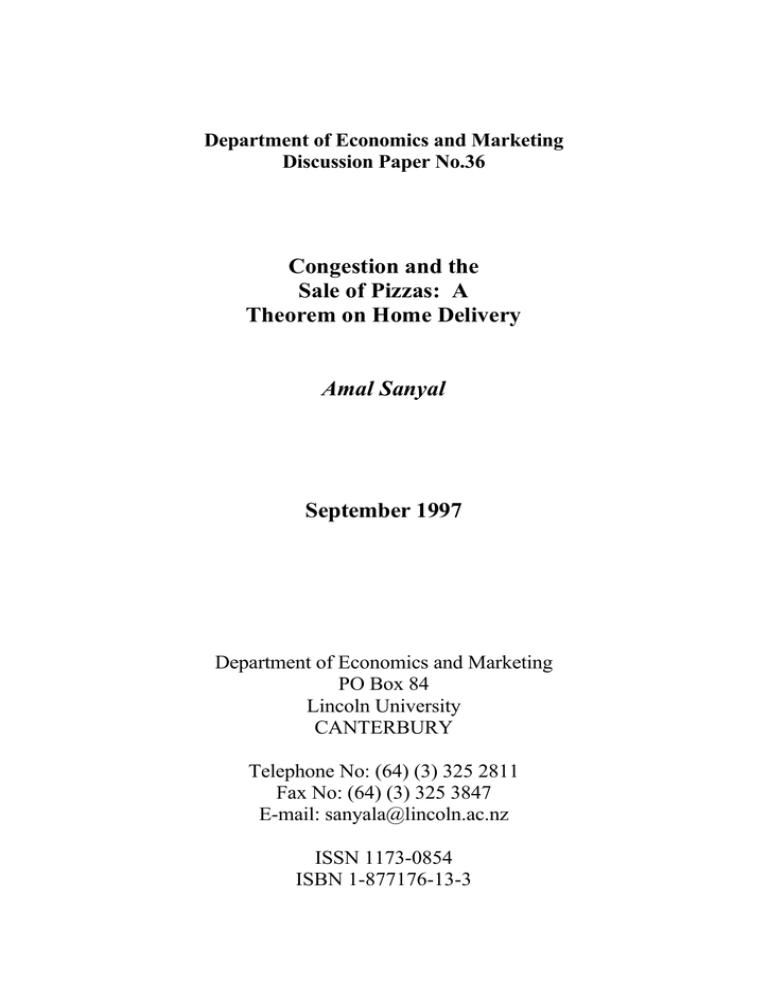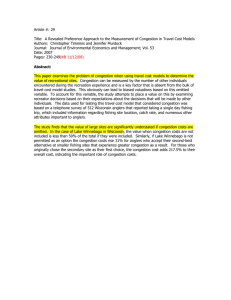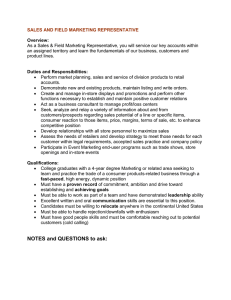Congestion and the Sale of Pizzas: A Theorem on Home Delivery
advertisement

Department of Economics and Marketing Discussion Paper No.36 Congestion and the Sale of Pizzas: A Theorem on Home Delivery Amal Sanyal September 1997 Department of Economics and Marketing PO Box 84 Lincoln University CANTERBURY Telephone No: (64) (3) 325 2811 Fax No: (64) (3) 325 3847 E-mail: sanyala@lincoln.ac.nz ISSN 1173-0854 ISBN 1-877176-13-3 Contents 1. Introduction 1 2. The Model 2 3. An Assumption about Choice 3 4. The Theorem 4 5. Proof 4 6. Discussion 5 References 6 1. Introduction Recently the pricing problem of a monopolist producing several different qualities of a product has received some attention in the literature. Mussa and Rosen (1978) studied the optimal product mix of a monopolist producing different qualities and facing consumers differentiated by their preference for quality, and Itoh (1983) analysed the welfare aspects of the problem. Gabszewicz and Thisse (1980), Shaked and Sutton (1982) and Gabszewicz et al (1986) have examined the relation of the degree of heterogeneity among consumers, and the number of firms characterising the market in equilibrium. In this literature, product quality is exogenous. By contrast, situations where product quality is endogenously determined by the number of consumers in the market has received less attention after the early work of Levy-Lambert (1968) and Marchand (1968) in the theory of general equilibrium and clubs. Congestion externality however is an important feature in a wide variety of industries. Since the quality of a service fast deteriorates with increase in number of customers relative to servicing capacity, almost all service industries, and product industries with a significant service component (e.g. retailing, restaurants, bars) are prone to congestion externality. Recently two papers by Chander and Leruth (1989) and Leruth (1993) have developed a model of product differentiation by congestion level in a market with heterogeneous consumers, and shown that with heterogeneous consumers, a monopolist finds it optimal to product differentiate through congestion levels. The present paper relates to the general issue of monopolist decision making under congestion and heterogeneous consumers, but examines a different problem. In some industries it is possible for the seller to offer a product with zero congestion by means of home delivery. Home delivery is then used as a way of reducing congestion in the selling place thus improving the quality of the product sold there and increasing its demand. At the same time it creates a second product with zero congestion and can mop up consumer surplus from the other, more congestion-conscious end of the market. Home delivery of pizzas, for example, is not only a product that saves consumers’ transport cost but also serves to deliver the product without the congestion at the eating place or the queue for takeaway. In a wide variety of service products like tutoring, hair cuts, midwifery, counselling, therapeutic massages, and so on home delivery of the service is a fast growing development in many countries and they have already significant market shares. 1 Our paper relates to congestion-prone products where home delivery is logistically feasible. It argues that in situations of service congestion where consumers are differentiated by congestion consciousness, there generally exists an in-store sale-cum-home delivery plan that is better than the profit maximising solution without differentiation. The argument need not contradict the general belief that home delivery business thrives on the discount that consumers get on their transport cost. It provides additional insight into home delivery service as a decongestant mechanism. To keep the arguments related to an example, we use a monopolist selling pizzas in a market where consumers have different levels of dislike for congestion at the eating parlour ( or the takeaway counter). But the arguments equally apply to all commodities prone to congestion wherever home delivery is feasible. To keep the model simple, we abstract from the issues related to location and transport cost in the following discussion. 2. The Model Consider a pizza-selling monopolist facing a market with the following characteristics: 1. Perceived quality of the product deteriorates with congestion in the selling place. It is represented by an index k = k(Q) , where Q is the number of in-store buyers, k > 0 and k <0. We will use ‘congestion’ and ‘the number of in-store buyers’ synonymously, both denoted by Q. Perceived quality of the product, if home delivered, is denoted by k(0) and k(0)> k(Q) for all Q >0. 2. Consumers are heterogeneous and derive different levels of utility from any given quality. When the i-th consumer buys a unit of the product of quality k at price p, her surplus is described by: Si = ti . k - p (1) where t i >0 is a subjective index of preference for quality. Consumers are imagined as arranged in the ascending order of the value of their subjective index t. The number of consumers with index t is given by a density 2 function f(t) over the domain T 1 tT 2 .The function f(t) is integrable and everywhere positive. 4. A consumer either buys only one unit or does not buy at all. A unit is bought by the ith consumer only if S i 0 5. If Q is the number of consumers buying the product, the lowest value of t for which the product is bought by some consumer is denoted by t 0 and is given by: t 0 . k(Q) - p =0 (2) For consumers with t i < t 0 , S i is negative, and they do not buy the product. Note that for a level of congestion Q , t 0 is given by t 0 = p/ k(Q) 6. (3) Marginal cost of producing pizzas and delivering them at home is fixed and zero. If the monopolist is offering only one product, i.e. undifferentiated by quality, at a price p, then profit is given by p. Q, where Q = T2 f (t )dt , and the problem is to set p so as to t0 maximise Call it Problem 1. We propose to show that if there is an interior solution to this problem then the monopolist can increase profits above that solution value by introducing a home delivery option at an appropriate charge. To characterise choice between in-store buying and home delivery we introduce the following assumption. 3. An Assumption about Choice A customer buys in-store or takes home delivery depending on which mode of purchase yields higher consumer surplus. Also we assume that indifference results in in-store purchase. When the number of in-store consumers is Q, a consumer with index t i takes home delivery if t i . k(Q) - p < t i . k(0) - p - D 0 (4) 3 where D is the home delivery charge. Writing the first inequality in (4) as an equality t i . k(Q) - p = t i . k(0) - p - D (5) and calling the solution for t i as t 1 , we have: t 1 = D /[ k(0) - k(Q)] Thus if the congestion is Q, for t 0 t i (6) t 1 a consumer buys in-store, while for t 1 t i T 2 a consumer opts for home delivery. 4. The Theorem If Problem 1 has an interior solution, then there is an in-store sale-cum-home delivery option that generates a profit higher than the solution value of Problem 1. 5. Proof Let the profit maximising price for Problem 1 be p*, and the solution values of t 0 , and Q be t 0 *, * and Q* respectively. Since it is an interior solution, in view of (3), we have 0 < t 0 * = p* / k(Q*) < T 2 and * = p*. (7) T2 f (t )dt (8) t0 * Imagine now that the price for in-store sale is maintained at p*, but a home delivery option is introduced at an additional charge D, such that p* D T2 k ( Q*) k ( 0) k ( Q*) (9) 4 p* and D would now repartition the domain of t at some 0 = such that for 0 t i p* D and 1 = k ( Q*) k ( 0) k ( Q*) 1 a consumer buys in-store, while for 1 t i T 2 a consumer opts for home delivery. Condition (9) is to ensure that 0 < 1 < T 2 . This partition however is not sustainable. Now that some people are taking home delivery, congestion will be less than Q* and the values 0 and 1 will have to alter. The equilibrium configuration that will emerge will feature a different congestion level as well as correspondingly different partition points . Denote the equilibrium partition points as t 0 and t 1 and the number of consumers buying int1 store by Q 1 . Then Q 1 = f (t )dt while the values of t 0 and t 1 are those obtained from (3) t0 and (6) respectively by putting Q = Q 1 and p = p*. Also let the number of consumers taking T2 home delivery be denoted by Q 2 , so that Q 2 = f (t )dt . t1 t1 T2 t0 t1 The new profit is given by p* f (t )dt + (p*+D) T2 = p* t0 f (t )dt T2 f ( t ) dt + D f (t )dt (10) t1 Given that f(t) is everywhere positive, an examination of (8) and (10) shows that a sufficient condition for is that t 0 * t 0 . This can be shown to hold by contradiction. Suppose t 0 *< t 0 . Then T2 T2 t0 * 0 f (t )dt > t t1 f ( t ) dt > f (t )dt , which implies Q* > Q 1 . t0 In turn this implies k (Q 1 ) > k (Q*), since k <0 by assumption. Therefore [p*/ k (Q*)] > [p*/ k (Q 1 ) ], i.e. t 0 *> t 0 which is a contradiction. 6. Discussion This result implies that any D consistent with (9) as home delivery charge and p* as price does better than the best undifferentiated price p*. That a D consistent with (9) exists is ensured by 5 the fact that Problem 1 has an interior solution, characterised by (7). The intuition behind the result is fairly simple. If home delivery is introduced, and some consumers opt for it, it reduces congestion compared to the undifferentiated optimum and thus brings along additional consumers who were earlier deterred by congestion. On the other side of the distribution, those consumers who are leaving the store, are but going to opt for home delivery and are therefore actually paying higher than they were earlier. So the monopolist can not but gain by introducing the home delivery option. We should however point out that (p*, D) is not purported to be the profit maximising solution with home delivery, which in general is expected to be some other vector. If there is a positive but constant marginal cost m for unit home delivery, the proof remains the same, except that there should be some D consistent with (9) with the additional requirement that D-m >0. If m is too large this may not be possible. However note that we have worked in terms of a sufficient condition for It is therefore possible that even if there is no D in (9) such that D - m >0, may still exceed References Chander, P and L. Leruth, (1989), The optimal product mix for a monopolist in the presence of congestion effects, International Journal of Industrial Organization, 7, 437-449. Gabszewicz, J.J and J.F. Thisse, (1980), Entry(and exit) in a differentiated industry, Journal of Economic Theory, 327-328. Gabszewicz, J.J, A. Shaked, J. Sutton and J. F. Thisse, (1986), Segmenting the market: The monopolist’s optimal product mix, Journal of Economic Theory, 88-104. Itoh. M, (1983), Monopoly, product differentiation and welfare, Journal of Economic Theory, 88-104 Leruth, L, (1993), Product Differentiation and Congested Goods in: Dutta, B, S. Gangopadhyay, D. Mookherjee, and D. Ray eds Theoretical Issues in Development Economics, Oxford University Press, Bombay. Levy-Lambert, H , (1968), Tarification des services à qualité variable: Application aux péages de circulation, Econometrica, 564-579. Marchand, M, (1968), A note on optimal tolls in an imperfect environment, Econometrica, 575-581. Mussa. M and S. Rossen, (1978), Monopoly and product quality, Journal of Economic Theory, 301-317. Shaked. A and J. Sutton, (1982), Relaxing price competition through product differentiation, Review of Economic Studies, 3-13. 6





